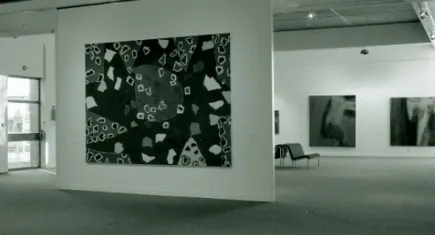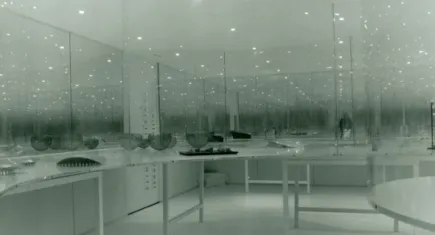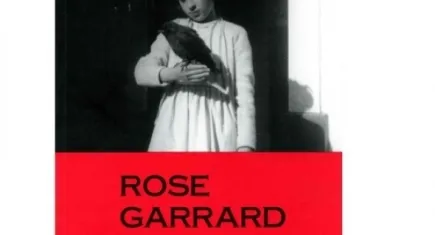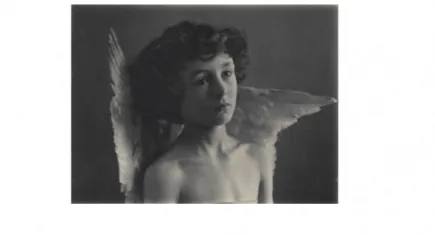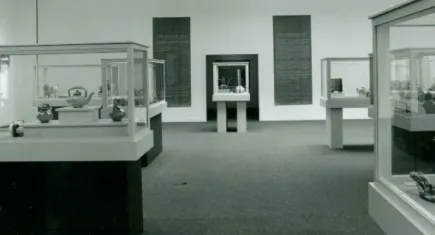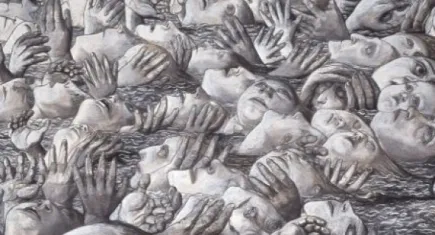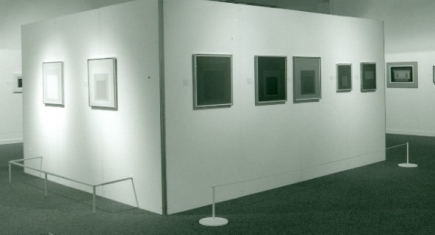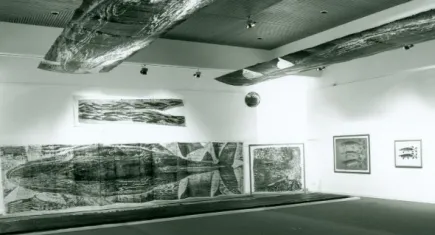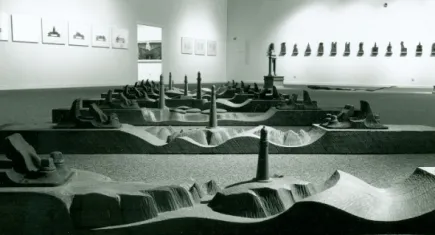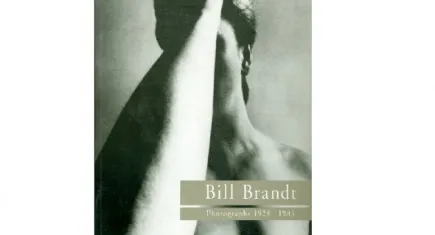Mead Gallery Exhibitions 1994
Paintmarks
Exhibition organised by Kettle’s Yard, Cambridge
Sat 12 Nov – Sat 10 Dec 1994
This exhibition features new work by some of today’s leading painters including Basil Beattie, Jennifer Durrant, Callum Innes and Hughie O’Donoghue. These artists have a common preoccupation with gravity, space, light and other elemental qualities. Their paintings are shown alongside the work of an older generation of paintings including Joan Eardley, Ivon Hitchens and Peter Lanyon whose work of the late 1950s and 1960s took landscape painting to the verge of abstraction
Following this exhibition, it was decided to acquire a work by Callum Innes for the University of Warwick Art Collection and one was finally purchased in 1996
A Sparkling Party
Initiated and organised by the VIZO Crafts Department, Brussels and toured in the UK by Craftspace
Sat 5 Nov – Sat 10 Dec 1994
A multi-sensory environment created in the gallery celebrates the work of 30 contemporary European silversmiths. An international jury selected the pieces which aim to be festive objects that might serve a useful purpose at celebrations.
Visitors step enter a huge black box to find themselves in a bright white room. The light of small spotlights sparkles in glass, silver and mirrors, reflecting and multiplying both objects and visitors around the walls while a specially commissioned piece of music adds to the silvery and sparkling sensations.
The Mead Gallery is the only UK venue for this exhibition.
Living Archives: Works by Rose Garrard 1973-1994
Exhibition organised by Cornerhouse, Manchester
Sat 1 Oct – Sat 5 Nov 1994
Gender and identity are at the centre of Garrard’s work. Using a range of media, she examines the relationships between art, the artist and audience and explore the histories of women.
During the 1970s, Garrard become known for multi-media and work which changed through time, challenging the traditional boundaries between categories of fine art. This exhibition of installations demonstrates Garrard’s major concerns over the past two decades. This is a landmark exhibition of a British artist whose work continues to challenge. It offers a new curatorial approach to the examination of the career of an artist whose work embraces live performance.
Exhibition supported by the Henry Moore Foundation and Arts Council England
Edwardian Women Photographers: Christina Broom, Olive Edis, Alice Hughes, Eveleen Myers
Exhibition organised by the National Portrait Gallery as part of the Festival of Women’s Photography
Sat 1 Oct – Sat 29 Oct 1994
This exhibition features the work of four important Edwardian photographers. Their subjects range from statesmen to suffragettes to the newly formed London Women’s Police Force. They reveal the changing position of women in British society in the early nineteenth century.
“Portraiture” declared the eminent photographer H.S. Mendelssohn in 1903 “is now in the hands of the women”. Twelve years earlier in 1890 only one woman ran a leading West End photography business. The fourth exhibition in the NPG’s Photography Gallery explores the changing role of women in Edwardian society by focusing on the careers of four important pioneer women photographers and forms the NPG’s contribution to SIGNALS: Festival of Women Photographers.
Eveleen Myers (1856-1937) began her photographic career in 1888 in order to record the early lives of her three children Leo, Silvia and Harold. She was inspired to take up photography from memories of a visit to Julia Margaret Cameron. Myers experimented with Cameron’s Pre-Raphaelite style and she specialised in studies of children, genre scenes and portraits of eminent contemporaries such as Gladstone, Browning, Maria Spartali Stillman and her own sister, Dorothy Tennant, the artist, and the explorer, Henry Morton Stanley.
Alice Hughes (1857-1939), the daughter of the painter Edward Hughes, first took up photography to record her father’s work before making her own portraits from 1892 onwards. Remarkably successful as a society and royal portraitist, Hughes was one of the most successful photographers of women in the Edwardian era, inspiring a large number of other women to take up photography as a career. Among the portraits included are Daisy, Countess of Warwick, Queen Mary and Queen Alexandra.
Christina Broom (1856-1939) was Britain’s first woman press photographer. Her photographic career began in 1903 when she published her first news photographs as postcards. In thirty-six years her work embraced a wide variety of subjects including the Oxford and Cambridge boat race crews, historical pageants, theatrical garden parties, Suffragette meetings and official photographs of the Household Brigade, as well as many portraits of the Royal Family.
Olive Edis (1876-1955) took up photography in 1900 and operated a successful studio for over thirty years in Sheringham, Norfolk, as well as working in other studios in London and Farnham. Some of Edis’ most interesting work are her documentary photographs of women’s contribution to the war effort in the First World War in France and Flanders (she was the only woman allowed to cover this) and her unique early colour photographs of eminent subjects such as Thomas Hardy, G.B. Shaw, Ramsay MacDonald and the Pankhursts.
The American Way: Views on Use - Function in American Ceramics
Exhibition organised and toured by Aberystwyth Arts Centre
Sat 4 Jun – Sat 2 Jul 1994
The current British perception of American ceramics is dominated by names which first came to prominence in the 190s and 1960s. Domestic, functional ceramics in particular have never been associated with North America despite much imaginative and exciting work being made by a younger generation of artists.
Two of the USA’s best known ceramicists were asked to select an exhibition of ‘usable’ ceramics as opposed to the purely sculptural works more often associate with North American ceramics.
Twenty-one artists were finally selected and the exhibition reveals a plethora of approaches to function. Some refer to English traditions while others explore the boundaries between art and craft.
Eileen Cooper: Lifelines
Exhibition organised and toured by the Benjamin Rhodes Gallery
Sat 28 May – Sat 2 Jul 1994
The brightly coloured paintings of Eileen Cooper have an immediacy and a potency which invite response. Her vivid studies of the relationship between women and men, children and the natural world are undoubtedly rooted in a personal narrative and yet allow recognition of the viewer’s own experience.
In this exhibition of recent work, Cooper explores more complex situations She continues to used the same characters but there is a greater sense of questioning and dilemma. Her beautifully simple figures are placed outside the contemporary material world, allowing a concentration on human emotions.
Antinomies: Works by Evelyn Williams
A Mead Gallery Touring Exhibition, co-curated with Professor Christine Battersby
Sat 23 April – Mon 30 May 1994
Evelyn Williams’ work explores human relationships. Not only does she establish formal rhythmic relationship between figures but she charges them with intense emotion. Her work has been difficult to categorise but this exhibition seeks to establish a new critical framework for it that places it within a new context of the feminist sublime.
The exhibition is accompanied by a Mead Gallery publication with an essay by Christine Battersby and notes from her life by Evelyn Williams.
Obituary: The Guardian, Tuesday 4 December 2012
Evelyn Williams: Artist whose work combined vision, dream and reality
David Alston
The artist Evelyn Williams has died aged 83. Hardly a day in her working life was not spent, in part or whole, in her calm and quiet studio in Finsbury Park, north London. On her easel, a matter of weeks before her death, was an ambitious image of an effulgent ruby red flowering shrub. From her earliest drawings, vision, dream and reality combined; she characterised her work as “inner thoughts, other worlds”.
Her work can be sought out in public collections: the Victoria and Albert Museum, the Arts Council Collection, the Graves Art Gallery in Sheffield, the collection of the Contemporary Art Society for Wales and Amgueddfa Cymru National Museum Wales. The spread of works in private collections reaches the US and Australia.
She proved hard to categorise and for some the preoccupations left them cold. Maybe the band of female abstract artists who are her contemporaries have had more acceptance than her obstinate figuration. Williams should certainly be regarded, along with friends such as Paula Rego, as having forged a path for female artists. She later founded a trust in her name which has done modest but important work to support artists, particularly women, and the practice of drawing.
Evie, as she was known, was born in London, the second daughter of Jenny, a career-orientated opera singer, and Brendan Williams, a radical Welsh writer. She was packed off to AS Neill’s progressive Summerhill school in Suffolk at not quite three and did not talk until she was four. She lived with an acute sense of vulnerability and in her adult life placed a tremendous value on familial love.
From the age of 15, she studied at St Martin’s School of Art and then went to the Royal College of Art, working alongside the older, largely male students, many of them soldiers returning from service in the second world war. When these men started making their way in the world through such focal points as the John Moores exhibition, there, in 1961, was this pesky Evelyn Williams winning the sculpture prize with a work entered as a collage.
Her career was punctuated by shows of scale. There was a retrospective, as early as 1973, at the Whitechapel, when critics were already struggling to characterise her powerful, affecting, but for the times, not mainstream art. Her large-scale reliefs were shown at Riverside Studios in 1984 and the ‘Out of the Forest’ exhibition at the Graves Gallery (1990) marked the transition away from the work on reliefs to large drawings and gradually more paintings, some of a scale comparable to the reliefs.
She permanently damaged her back working on monumental reliefs such as All Night Through (1984), now in the refectory of Murray Edwards (formerly New Hall) College, Cambridge. Exhibitions at the Mead Gallery, Coventry (1994), and at Manchester Art Gallery (1996) were marked by singular, visionary pictures.
In recent years there were exhibitions through Martin Tinney in Wales and with Agnew’s and Jane England in London. These works were often intimate and startling and although the paint became thinner, the power of imagination remained true to an unfolding world of figures in interiors or passing through increasingly deserted landscapes of woods and plains. She talked of her work with self-effacement but her words provide epitaphs: “After all the attempts at movement, the pulling and pushing of forms, the agitation – here all goes still and I have a sense of relief the figure is asleep and has found rest.”
Anthony Perry, her second husband, collected in a book the thoughts of people who have lived with Evie’s work on their walls over the years. It is an eloquent testimony of the solace, humour and power that people found in their daily encounters with her work.
She is survived by Anthony, whom she married in 1963, and their daughter, Sarah; by her daughter, Emma, from her earlier marriage to the painter Michael Fussell, which ended in divorce; and by nine grandchildren and three great-grandchildren.
Evelyn Jane Brendan Williams, artist, born 21 January 1929; died 14 November 2012
Josef Albers
A National Touring Exhibition organised by the Southbank Centre for the Arts Council of Great Britain
Sat 23 Apr – Sat 21 May 1994
The artist, designer and teacher, Josef Albers (1888-1976) is associated with the world famous but short lived design school, the Bauhaus. In a career which spanned more than six decades he produces a surprising variety of work in many different media. The exhibition explores the various strands of his work and demonstrates the important role he played in the transition from early 20th century modernism to the late modernism of the 1960s and 1970s.
The exhibition includes his early Expressionist drawings, collages, furniture, glass, graphic works and the paintings drawn from the collection of the Josef Albers Foundation, Connecticut.
Sponsored by British Telecom
Fish, Bird, Animal: Prints, Paintings and Drawings by Julian Meredith
A Mead Gallery Exhibition
Sat 19 Feb – Sat 19 Mar 1994
The unemotional tone of the title of this exhibition establishes Julian Meredith’s approach to portrayals of wildlife. He concentrates on the textures and markings of animals’ bodies. From a mass of closely observed and highly refined marks emerge images of fish swimming in deep water or among reeds.
Meredith uses planks of elms, oak, ash and pine for his woodblocks. He also uses birchfaced plywood which allows him to create larger images such as a thirty foot long whale.
Flint Sepulchre: Sculptures and Drawings by Keir Smith
A Mead Gallery Touring Exhibition
Sat 19 Feb – Sat 19 Mar 1994
Keir Smith is an artist who uses themes relating to landscape in his work. His ‘single signs’ of a ship’s funnel, a knot of rope, a bonfire, carved into Jarrah railway sleepers adorn the external walls of the Mead Gallery.
This new body of work reveals not only the development of his interest in architecture but the complex ideas and issues which underpin his work. ‘From the Dark Cave’ is a personal history of architecture and social history from St Mary’s Abbey on the Kent Coast to Canary Wharf in London.
In his latest work, produced especially for this exhibition, Smith mixes architectural and religious images with carvings of distorted flints. A series of carvings in railway sleepers examines coastal architecture and its relationship to the sea.
This is a beautiful and challenging exhibition which provides a rare opportunity to assess the mature work of one of Britain’s most important sculptors.
Obituary by Ann Elliot, The Guardian, Tuesday 3 April 2007
Keir Smith: Sculptor whose contemporary vision had its roots in the Renaissance
The sculptor Keir Smith, who has died at the age of 57 from cancer, was an artist of distinction and unusual vision. He dedicated his life to his art, looking at and writing about the arts of the past which nourished his contemporary practice as much as his interest and respect for the art that was going on around him. He was also a sensitive and dedicated teacher.
Named after James Keir Hardie, the first socialist Member of Parliament, Keir was born in Gravesend, Kent. His father was a member of the Labour party, and a local councillor, working at the docks in Tilbury. His parents believed strongly in education, and encouraged their four children to achieve. Keir was educated at Collier Road secondary school, and at Northfleet and Gravesend grammar school. He studied fine art at the University of Newcastle upon Tyne, where his mentor was the painter Ian Stephenson, whom Keir followed to Chelsea School of Art. It was at Chelsea that he moved from painting to working in three dimensions.
Art and architecture of the past, archaeology, mythology and landscape informed his early work. He dallied for a while with performance art, through slide shows in which he documented himself performing in the landscape, using objects that he had made and then articulated in different ways. These were shown in London at the Air gallery in 1977 and at the Acme gallery in 1980, and were his first solo exhibitions after leaving university.
His work in the public realm developed with early commissions for Grizedale Forest, Cumbria, where he was twice artist in residence (1979-80 and 1981-82). In fact, Keir was often chosen for outdoor sculpture projects during their formative years – Grizedale and Yorkshire sculpture park in the early 1980s, the Forest of Dean sculpture trail in 1986, and later, Sculpture at Goodwood, West Sussex, now the Cass Sculpture Foundation in 1997 are important examples.
His first experience of a group exhibition was the Northern Young Contemporaries at the Whitworth art gallery, University of Manchester (1973), in which he was a prizewinner. Another exhibition, this time in Newcastle upon Tyne, also changed his life. When working on Ceres at the Spectro gallery in 1981, he met Clare Rowe. They married in 1997.
The sources for Keir’s mature work were based in the art, architecture and sculpture of the Italian Renaissance. He was passionate about little-known painters and sculptors as well as the masters, learned Italian and visited Italy regularly. The church of St Sigismondo in Cremona lies at the heart of many of his later works, most directly in Stefano (1997). Enabled by the Cass Sculpture Foundation, this was his largest bronze sculpture. Its subject is the first Christian martyr, St Stephen, who was stoned to death for his beliefs and teaching; hence the cairn of “golden” stones, and the single stone on the altarpiece.
Keir’s writings were extensive, personal, and at times very amusing. He was also somewhat akin to a gentleman pamphleteer, in that each of his later exhibition catalogues, many of which he published, contained his learned essays on the works that inspired him.
Keir’s own vision, however, was entirely contemporary. His stone carvings and woodcarvings were spare and direct, with clean line and pure surface. Bronzes were first modelled, then cast, either at Wimbledon College of Art, where he taught, from 1991 until his death, or at his studio in Butley Mills, near Orford in Suffolk. Both were small-scale foundries, but Keir made his pieces in sections, which were then bolted or welded together to gain a larger presence.
A Mead Gallery Touring Exhibition
Sat 19 Feb – Sat 19 Mar 1994
Drawing was vital to Keir, not so much as plans for sculpture, but works of tangential subject matter, often worked carefully in pencil and watercolour or made in acrylic over long periods of intense activity. He was never without a sketchbook. Towards the end of his life, during bouts of chemotherapy, unable to sleep at four in the morning, he would walk to the Thames, where he drew and painted the water, bleak compositions with broken wooden poles rising through the surface.
The sculptural frieze for Henrietta House, Richmond, London, sited at Henrietta Place, was Keir’s most ambitious commission, completed in 1992. Working through the Public Art Development Trust, he designed the frieze on the theme of the history of buildings, from the cave to the tower of One Canada Square, Canary Wharf, London. These frontal sculptures were carved in deep relief, much bolder and more three-dimensional than the shallow carving that bas-relief allows. He employed geometric form and references to elements of his favourite buildings, whether significant or utilitarian.
Keir was a kind and considerate man, driven by his work, sociable, funny and self-deprecating, but with no false modesty. He was a good teacher, liked and admired by his students, and greatly respected by his fellow sculptors. He is survived by Clare, his mother, a brother and sister.
Keir Owen Walter Smith, sculptor, born February 1 1950; died March 7 2007
Bill Brandt: Photographs 1928-1983
Exhibition curated by Ian Jeffrey and organised by the Barbican Art Gallery, London
Sat 8 Jan – Sat 12 Feb 1994
This is the first fully retrospective exhibition of the greatest British photographer of the twentieth century. It includes some of his most famous images as well as many which have never been seen before.
The exhibition opens with work from Brandt’s early visits to Hamburg, Paris and Barcelona followed by his social documentary work in inter-war Britain. This includes the fascinating and unfamiliar series of a day-in-the-life of a barmaid, waitress and parlourmaid. Other series of work include his studies of the mining industry taken for ‘Weekly Illustrated’ and ‘Picture Post’ and his wartime images of the subterranean communities in the London tube shelters.
Still-life compositions and a series of unconventional fashion plates appear to be preparation for the famous series of nude images that are almost abstract in their intensity. Portraits include a profile of Edith Sitwell and an early photograph of Francis Bacon. The exhibition concludes with his amazing collages made in the 1970s.

